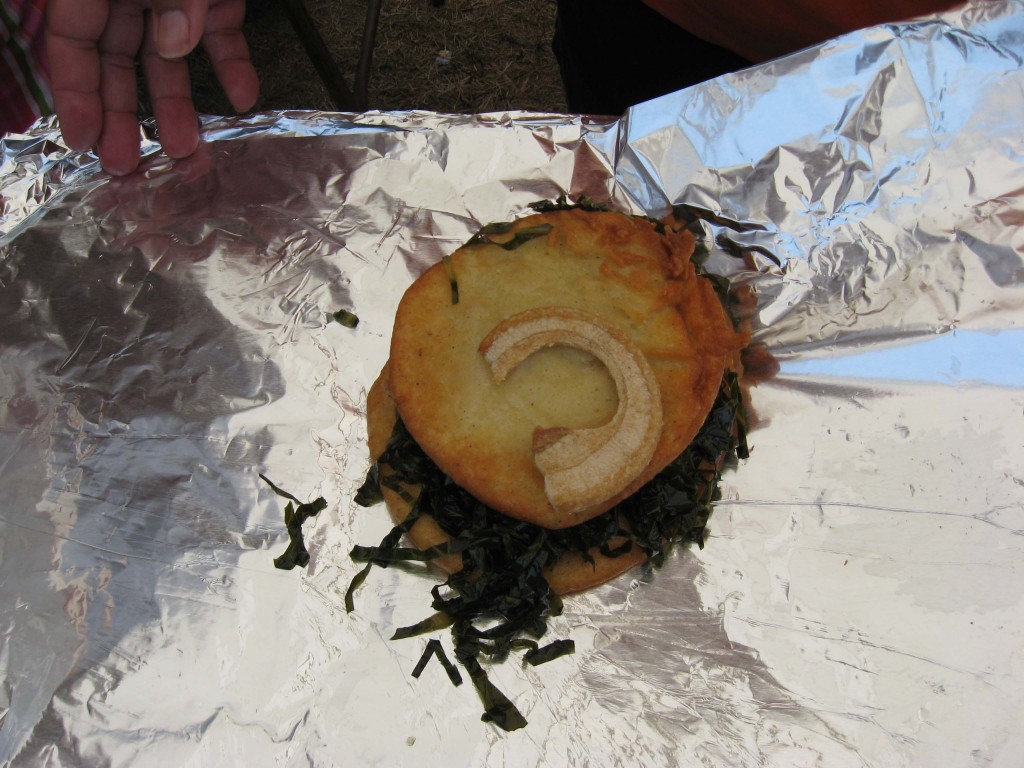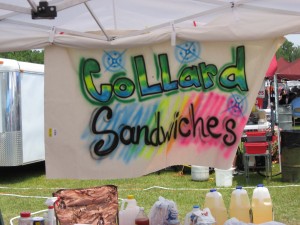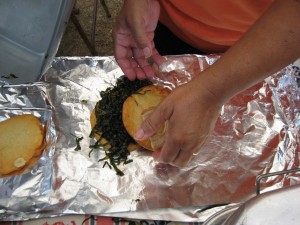FOOD FOR ALL: ODE TO THE SANDWICH
 The Lumbee-centric collard sandwich is on a roll, having been featured in magazines from Our State to Garden & Gun. We recently chatted with folklorist Jefferson Currie II about this culinary creation.
The Lumbee-centric collard sandwich is on a roll, having been featured in magazines from Our State to Garden & Gun. We recently chatted with folklorist Jefferson Currie II about this culinary creation.
Q: What is a collard sandwich?
A: It’s constructed with two pieces of fried cornbread. Most of the time the bread is fried in a cast-iron pan with grease, and it is just cornmeal and salt and pepper and water. Two big pieces of cornbread and collards. And then you put a piece of fatback or whiteside meat on the bone on it. At Lumbee Homecoming, you have chow-chow [a vegetable relish] as a side — it pulls in the different flavors. And it’s normally wrapped up in tinfoil for carrying and eating. So you’ve got one piece of cornbread at the bottom, collards, one piece of cornbread on top, and a lot of times they put the fatback on top.
 Q: When was the first time you tried a collard sandwich?
Q: When was the first time you tried a collard sandwich?
A: I don’t remember the exact first time, but it was at Homecoming years ago. I did a blog post for the North Carolina Folklife Institute [in 2008] on the collard sandwich. Cornbread is perfect — you don’t need anything with it. But with the collards, there’s a kind of salty [taste], then sweetness with the chow-chow — and there’s the meatiness with the fatback. And collards are very earthy. It kind of encapsulates a lot of different flavor profiles. I described it once at a food conference as the perfect food to understand colonialism. You’ve got the Spanish, who brought in hogs in the 1500s, and collards and greens were from the African region, and corn from the Americas. It’s the perfect food that melds all of that, which is what Southern food is — Indian, black, white — communities coming together.
Q: You mentioned Lumbee Homecoming. What is that?
A: In the ’30s, ’40s and ’50s, a lot of people were leaving North Carolina’s Lumbee community for work. Some went to Baltimore, Detroit, Greensboro, Charlotte. My family ended up near Raleigh. People started going away more for college and other reasons. It’s a way of bringing the community back together in Pembroke, N.C. You have pageants, golf tournaments, fun runs, a car show, people selling crafts. It kind of culminates on the Saturday around July 4. And the food – you’ve got collard sandwiches, barbecue, hotdogs and hamburgers, and chicken bog. Chicken bog is related to a lot of coastal dishes like purloo in Charleston and gumbo.
 Q: You participated in a project with Sara Wood of the Southern Foodways Alliance and UNC historian Malinda Maynor Lowery of the Southern Oral History Program at the Center for the Study of the American South to document Lumbee oral histories about food. Can you elaborate on this work?
Q: You participated in a project with Sara Wood of the Southern Foodways Alliance and UNC historian Malinda Maynor Lowery of the Southern Oral History Program at the Center for the Study of the American South to document Lumbee oral histories about food. Can you elaborate on this work?
A: We talked about agriculture and farming and also what people were cooking and how they cooked it. Sara has talked to people about church events and food, and she’s looked at restaurants like Old Foundry. There was tri-racial segregation in Robeson County, but Old Foundry was a place where Indians could go to eat.
Q: How does all of this tie in with your own interests and studies in folklore?
A: For me, food is about family. Food is about belonging. When I think of what I ate growing up, that’s what captures me. When I would visit my mama’s family — my Indian cousins, aunts and uncles — you would walk in the house and you would have to eat. It’s about that conversation that happens while you’re together. To me, the center of the house is a kitchen table. Food liberates and lubricates the conversation. Food is love.
Currie is a member of the Lumbee Tribe who graduated from UNC-Pembroke with a degree in American Indian studies. He currently works at the Vollis Simpson Whirligig Park and Museum in Wilson, N.C., as he completes his thesis for a master of arts in folklore in spring 2016.
Interview by Kim Weaver Spurr ’88; Photos courtesy of Jefferson Currie
Read about a folklore alumna’s dissertation on pimento cheese.
